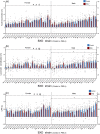Discovery of early life stress interacting and sex-specific quantitative trait loci impacting cocaine responsiveness
- PMID: 30874305
- PMCID: PMC6877791
- DOI: 10.1111/bph.14661
Discovery of early life stress interacting and sex-specific quantitative trait loci impacting cocaine responsiveness
Abstract
Background and purpose: Addiction vulnerability involves complex gene X environment interactions leading to a pathological response to drugs. Identification of the genes involved in these interactions is an important step in understanding the underlying neurobiology and rarely have such analyses examined sex-specific influences. To dissect this interaction, we examined the impact of prenatal stress (PNS) on cocaine responsiveness in male and female mice of the BXD recombinant inbred panel.
Experimental approach: BXD strains were subjected to timed mating and assigned to PNS or control groups. PNS dams were subjected to restraint stress (1-hr restraint, three times daily) starting between embryonic day (E) 11 and 14 and continued until parturition. Adult male and female, control and PNS offspring were tested for locomotor response to initial and repeated cocaine injections (sensitization) as well as cocaine-induced conditioned place preference (CPP).
Key results: Strain, PNS, and sex interacted to modulate initial and sensitized cocaine-induced locomotion, as well as CPP. Moreover, a quantitative trait locus (QTL) interacting with PNS regulating initial locomotor response to cocaine (chromosome X, 37.91 to 50.95 Mb) was identified. Also PNS-independent, female-specific QTLs regulating CPP (chromosome 11, 65.50 to 81.31 Mb) and sensitized cocaine-induced locomotion (chromosome 16, 95.79 to 98.32 Mb) were identified. Publicly available mRNA expression data were utilized to identify cis-eQTL and transcript covariation with the behavioural phenotype to prioritize candidate genes; including Aifm1.
Conclusions and implications: These QTL encompass genes that may moderate genetic susceptibility to PNS and interact with sex to determine adult responsiveness to cocaine and addiction vulnerability.
Linked articles: This article is part of a themed section on The Importance of Sex Differences in Pharmacology Research. To view the other articles in this section visit http://onlinelibrary.wiley.com/doi/10.1111/bph.v176.21/issuetoc.
© 2019 The British Pharmacological Society.
Conflict of interest statement
The authors declare no conflicts of interest.
Figures



References
-
- Alb, J. G. , Cortese, J. D. , Phillips, S. E. , Albin, R. L. , Nagy, T. R. , Hamilton, B. A. , & Bankaitis, V. A. (2003). Mice lacking phosphatidylinositol transfer protein‐α exhibit spinocerebellar degeneration, intestinal and hepatic steatosis, and hypoglycemia. The Journal of Biological Chemistry, 278(35), 33501–33518. 10.1074/jbc.M303591200 - DOI - PMC - PubMed
-
- Alexander, S. P. , Christopoulos, A. , Davenport, A. P. , Kelly, E. , Marrion, N. V. , Peters, J. A. , … CGTP Collaborators . (2017). The Concise Guide to PHARMACOLOGY 2017/18: G protein‐coupled receptors. British Journal of Pharmacology, 174(Suppl 1), S17–S129. 10.1111/bph.13878 - DOI - PMC - PubMed
Publication types
MeSH terms
Substances
LinkOut - more resources
Full Text Sources
Medical
Molecular Biology Databases
Miscellaneous

